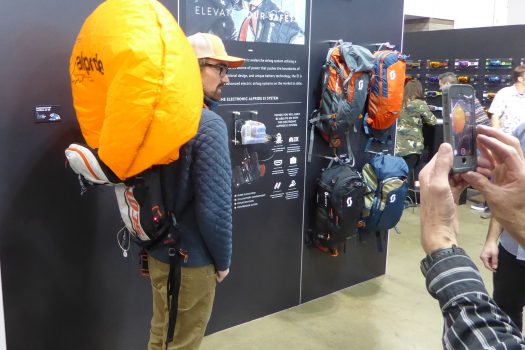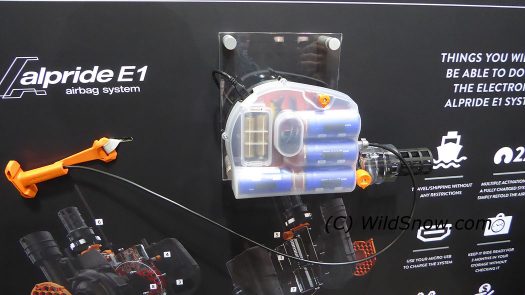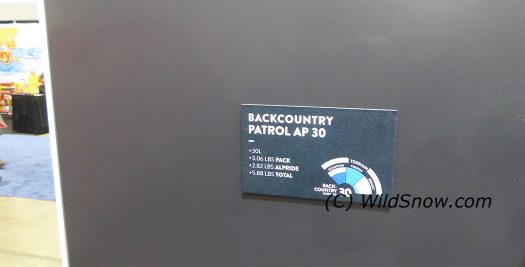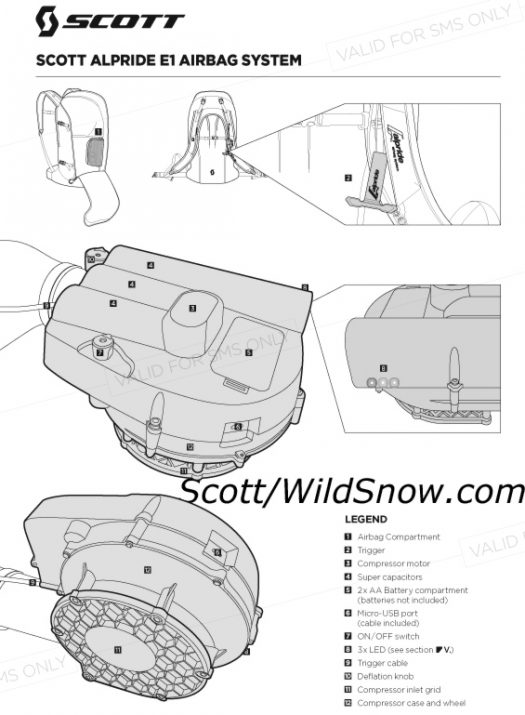As Alpride promises, so Alpride delivers (or so it appears). Here at Day 2 of Outdoor Retailer trade show, easily our most exciting booth visit was that of checking out the Alpride E1 electronic airbag system.
Massing at 1270 grams (2.8 pounds) for the entire airbag parts configuration (NOT THE BACKPACK, but the balloon, fan, power, etc.), E1 easily bests other electronic systems, and is what I’d call “average to below average” in weight compared to compressed gas systems (for example, one major brand’s system weighs 1200 grams). By way of total pack weight the Alpride 30 liter backpack model we feature here weighs 2670 gram (5.88 pounds) for pack and airbag engine system combined.
As I’ve covered in other blog posts, instead of batteries being the main power source E1 uses an array of super capacitors. I’ll not get into deep technicalities here, main advantage of the capacitors is they’re not near as sensitive to cold temperature power loss as a lithium ion battery. Thus, you can carry just enough capacitor “capacity” to inflate your airbag — you don’t need extra in case it gets cold.
The E1 can be charged in three ways. A typical wall wart gets things ready in 20 minutes, while a micro USB port is somewhat slower. A set of internal AA batteries primarily intended to keep the capacitors topped of will give you a charge in about 40 minutes. With AA batteries installed and the system powered down, a charge will last about three months.
We will soon have an Alpride E1 at WildSnow HQ for testing and review. Meanwhile, show photos and official verbiage.
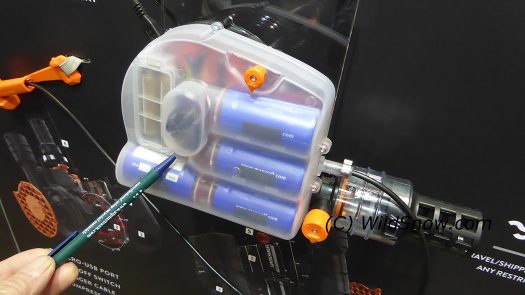
E1 guts in transparent display case. The blue cylindrical objects are the capacitors, you can see the two AA batteries as well, which do multiple duty as either for charge maintenance or renewal, but can be removed for a small weight savings. A typical set of fresh alkaline AA batteries will charge the system one time. A wall charger is provided for normal use, and the system can also be charge via a USB connector. No charging stone left unturned, or something like that.
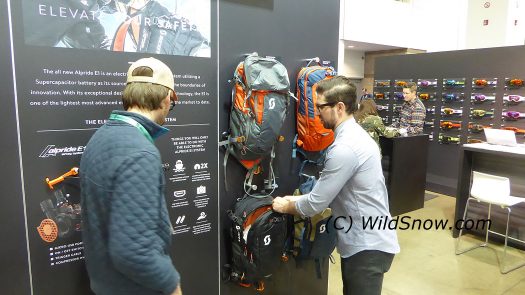
At the Scott booth. Expect to see this technology used in other brands once Scott’s one-year exclusive sunsets. We heard a rumor that Alpride is in negotiations with Black Diamond,for example. Makes sense, as comparing an 8 pound Jetforce to this, something like seeing the writing on the wall? Of course Jetforce is available now, not next season — I’ll give it that!
Below from the Scott Alpride official infos, edited.
BACKCOUNTRY PATROL AP 30 BACKPACK
The SCOTT Backcountry Patrol AP 30 backpack is the ultimate freeskiing backpack featuring the new electrical Alpride E1 airbag system. With its supercapacitor technology, along with its exceptional design the Alpride E1 system is clearly one of, if not the lightest electronic airbag systems on the market to date.The system solves battery-related limitations that have been difficult if not insurmountable for lithium-ion based avalanche airba systems. Without the need for extra capacity and weight, it performs in temperatures from -30 to +50 degrees centigrade, and can be recharged an essentially infinite 500,000 times rather than the finite number of charges possible with batteries. It inflates once per charge, with a variety of options for recharge (see below).
MSRP is 900 euro, available fall of 2018.
HEIGHT: 60cm, WIDTH: 28cm, DEPTH: 19cm VOLUME: 30L APPROX. WEIGHT: 1390g Backpack, 1280g Alpride System total = approx. 2670g
FEATURES + SCOTT ALPRIDE AIRBAG SYSTEM E1 + TÜV-certied avalanche airbag + Diagonal ski carry system + Side compression straps with A-frame ski carry system and front snowboard carry function + Separate sleeves for safety equipment (shovel, probe) inside the main compartment + Top pocket with fleece lining + Stow away ice axe/pole holder + Versatile daisy chain loops + Light hip belt with safety leg loop + SOS label with emergency instructions + Sternum strap with emergency whistle + Inside map pocket with key holder.
2x AA BATTERIES
The E1 SuperCap System uses two AA batteries for two primary purposes: 1) to recharge the SuperCapacitors 2) to guarantee that the SuperCapacitors keep their full power, compensating for their slow loss of charge and ensuring several months of autonomy (Wildsnow note: capacitors in some cases do not hold a charge as well as a lithium-ion battery, but neither type of electrical storage is 100% in that regard).Only alkaline or lithium (AA batteries) should be used (lithium for quick recharging at very low temperatures). Use brand new, premium quality Alkaline AA/LR6 batteries. Do not use AA zinc carbon batteries and NiCd or NiMH accumulators (rechargeable). These are often not strong enough to sufficiently charge the SuperCapacitors.
Depending on the AA batteries technology, recharge and “autonomy” can vary: Alkaline batteries are capable of 1 recharge OR 3 months autonomy of normal use (1.5 month if constantly on) — change the batteries after 1 recharge of the system. Lithium batteries are capable of 3 recharge OR 5 months autonomy of normal use (3 months if constantly on). (Wildsnow Note: Autonomy refers to the length of time the system will remain charged.)
The micro-USB port (5 volt 2 amp) makes it possible to recharge the SuperCapacitors using micro-USB cable. Charging can be completed with a standard USB charger (not included), like those used for cell phones. Recharging the SuperCapacitors with the micro-USB cable takes priority over recharging via the AA batteries (Wildsnow comment: the AA bats are not required for day use of a fully charged system, and could thus be used as a reserve battery source or removed to save weight). The SuperCapacitors can be recharged with the micro-USB cable even in the absence of the AA batteries.
NOTE: In some browsers images below may not enlarge correctly without a few extra steps. In testing, I right click then “open in new tab,” I can then enlarge. Experiment.
WildSnow.com publisher emeritus and founder Lou (Louis Dawson) has a 50+ years career in climbing, backcountry skiing and ski mountaineering. He was the first person in history to ski down all 54 Colorado 14,000-foot peaks, has authored numerous books about about backcountry skiing, and has skied from the summit of Denali in Alaska, North America’s highest mountain.

